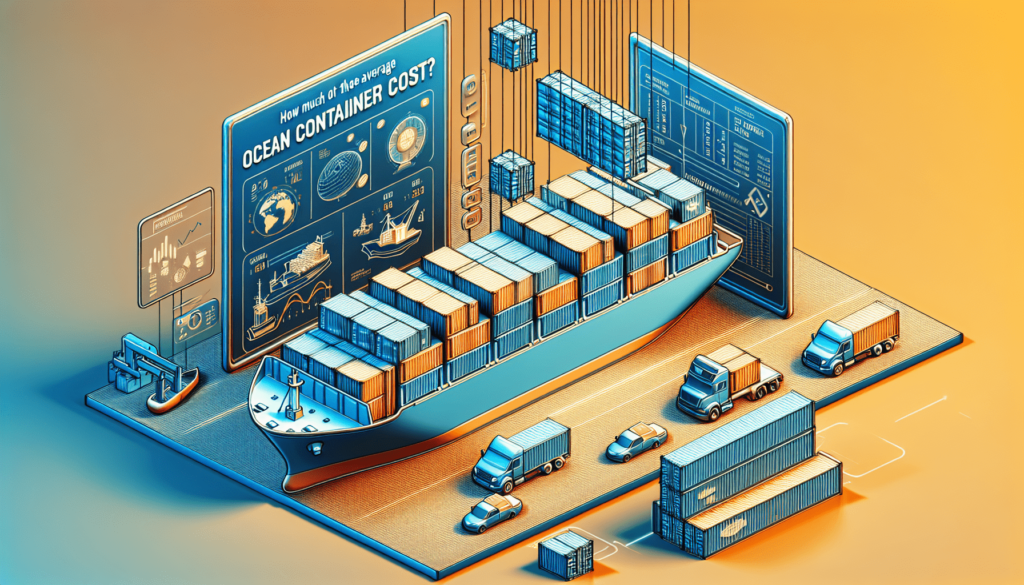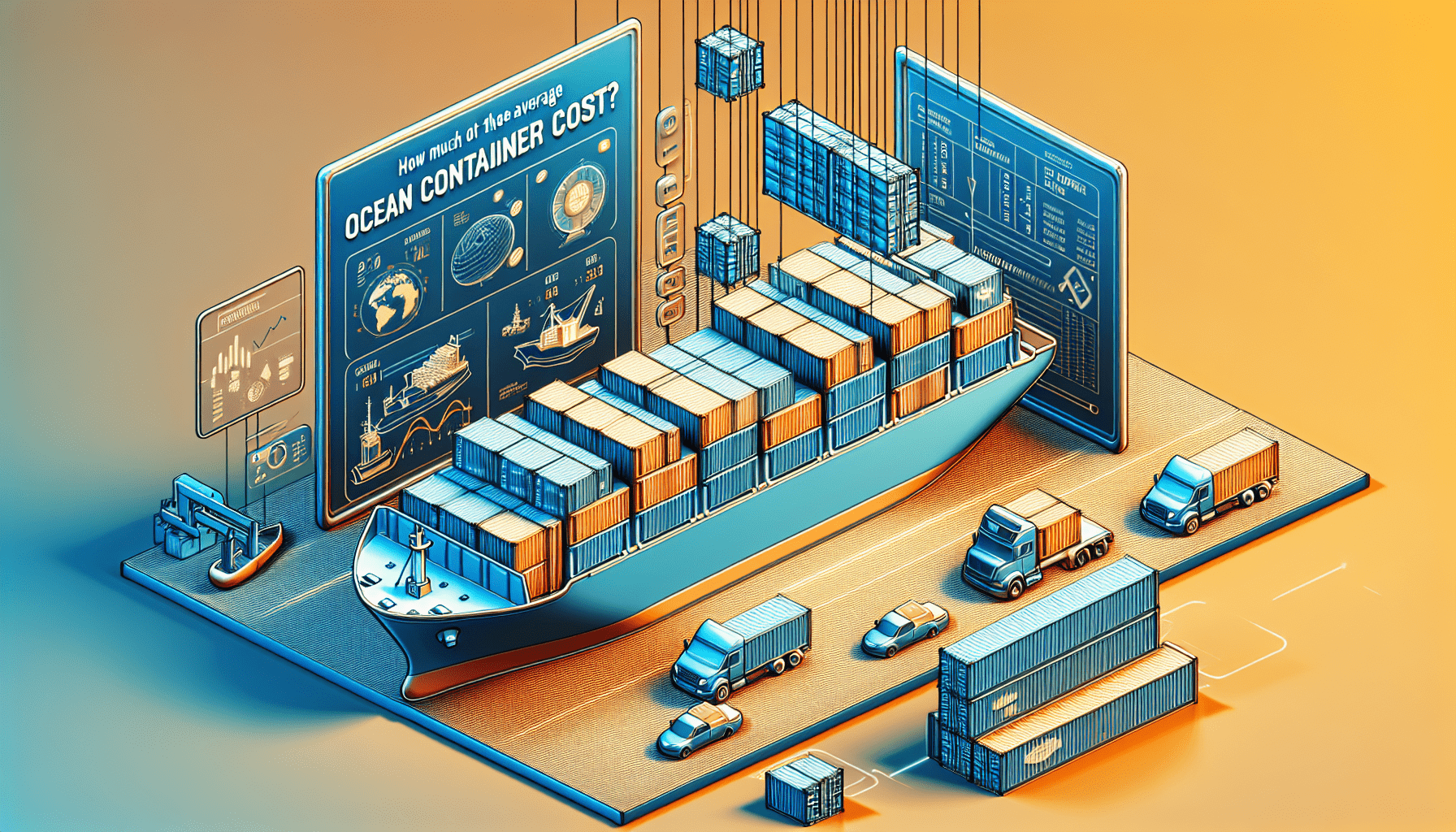If you’ve ever wondered about the cost of shipping goods across oceans, you may have come across the term “ocean container” in your research. But just how much does an average ocean container cost? From the various factors that influence the price to the current trends in the shipping industry, this article will provide you with a clear understanding of the average cost of an ocean container and what you need to know before making a shipping decision.

Factors that impact the cost of ocean containers
When it comes to shipping goods via ocean containers, there are several factors that can impact the cost. Understanding these factors can help you make informed decisions and manage your shipping budget effectively. Here are some key factors that can affect the cost of ocean containers:
Container type and size
The type and size of the container you choose will have a significant impact on its cost. Standard ocean container sizes include 20-foot, 40-foot, and 40-foot high cube containers. The larger the container size, the higher the cost will typically be. Additionally, different types of containers, such as refrigerated containers or open-top containers, may come with additional costs due to their specific features and functionalities.
Shipping distance and route
The distance and route of your shipment play a crucial role in determining the cost of ocean containers. Shipping goods over long distances or through complex routes may require additional resources, including fuel and labor, which can drive up the overall price. Additionally, factors like port congestion or remote destinations can also impact the cost of shipping.
Shipping season and demand
The season in which you choose to ship your goods can affect the cost of ocean containers. During peak shipping seasons, such as the holiday season, demand for containers tends to be higher, leading to increased prices. It’s important to consider the time of year when planning your shipments to ensure you’re aware of any potential price fluctuations.
Container condition and age
The condition and age of the container can also influence its cost. New or well-maintained containers may come at a higher price compared to older or damaged ones. It’s essential to assess your cargo’s requirements and consider whether investing in a newer container is worth the additional cost in terms of security and protection for your goods.
Transportation costs
In addition to the cost of the container itself, transportation costs play a significant role in the overall expenses. The cost of moving containers from the port to the final destination can vary depending on factors like fuel prices, distance, and local transportation infrastructure. It’s important to consider these transportation costs when budgeting for your shipping needs.
Customs and duties
Depending on the nature of your goods and the countries involved in the shipment, customs and duties may apply. These additional fees can significantly impact the overall cost of ocean containers. It’s crucial to research and understand the customs regulations and duties of the countries you are shipping to in order to accurately calculate the total cost.
Currency exchange rates
When dealing with international shipping, currency exchange rates can also affect the cost of ocean containers. Fluctuations in exchange rates between the currency you are paying in and the currency of the shipping line or carrier can impact the final price you pay. It’s important to monitor exchange rates and consider any potential currency risks when budgeting for your shipments.
Standard ocean container sizes and their costs
Ocean containers are available in various sizes to accommodate different cargo volumes. The most common standard container sizes are 20-foot, 40-foot, and 40-foot high cube containers. Here’s an overview of these standard container sizes and their associated costs:
20-foot container
A 20-foot container, often referred to as a “twenty-footer,” is one of the most commonly used container sizes in international shipping. This container size typically has a maximum payload capacity of approximately 28 metric tons. The cost of a 20-foot container can vary depending on factors such as the shipping line or carrier, the specific route, and the current market conditions. On average, the cost of a 20-foot container can range from $1,500 to $3,000.
40-foot container
The 40-foot container, also known as a “forty-footer,” is another widely used container size in ocean shipping. This container size provides more space compared to the 20-foot container and has a maximum payload capacity of about 26 metric tons. The cost of a 40-foot container can vary depending on various factors such as the shipping line or carrier, the specific route, and the current market conditions. On average, the cost of a 40-foot container can range from $2,500 to $5,000.
40-foot high cube container
The 40-foot high cube container is similar in size to the standard 40-foot container but offers additional height. This increased height allows for more vertical storage capacity. The maximum payload capacity of a 40-foot high cube container is approximately 26 metric tons. The cost of a 40-foot high cube container can vary depending on factors like the shipping line or carrier, the specific route, and the current market conditions. On average, the cost of a 40-foot high cube container can range from $2,800 to $5,500.
Different types of ocean containers and their costs
In addition to different sizes, ocean containers come in various types, each designed to meet specific shipping requirements. Here are some different types of ocean containers and their associated costs:
Standard dry containers
Standard dry containers are the most common type of ocean containers used for shipping general cargo. These containers are suitable for goods that don’t require any special temperature, ventilation, or storage conditions. The cost of standard dry containers is typically lower compared to specialized containers, with prices ranging from $1,500 to $4,000, depending on size and other factors.
Refrigerated containers
Refrigerated containers, also known as reefer containers, are designed to transport perishable goods that require temperature control. These containers come with built-in refrigeration units and are equipped with temperature monitoring systems. Due to their specialized features, refrigerated containers are generally more expensive than standard dry containers. The cost of refrigerated containers can range from $4,000 to $8,000, depending on size and other factors.
Open-top containers
Open-top containers are used for cargo that cannot be loaded through the standard doors of a dry container. These containers have removable roofs, allowing for top-loading or the transportation of oversized cargo. The cost of open-top containers can be higher than that of standard dry containers due to their unique design. Prices for open-top containers typically range from $2,500 to $6,000, depending on size and other factors.
Flat rack containers
Flat rack containers are designed to transport oversized cargo or goods that cannot fit within the dimensions of a standard container. These containers have collapsible or removable sides, making them suitable for items like machinery, vehicles, or heavy equipment. The cost of flat rack containers can vary depending on factors such as size, collapsibility, and other specifications, with prices ranging from $2,500 to $6,500.
Tank containers
Tank containers are specifically designed for the transport of liquids or gases. These containers come with built-in tanks that can safely store and transport hazardous or non-hazardous liquids. Tank containers are generally more expensive than standard dry containers due to their specialized nature. The cost of tank containers can range from $5,000 to $10,000, depending on size, type, and other factors.
Ventilated containers
Ventilated containers are designed to provide airflow and ventilation for certain types of cargo that require proper ventilation, such as fruits, vegetables, or flowers. These containers feature vents on the sides, allowing for the circulation of air to maintain the freshness and quality of the cargo. The cost of ventilated containers can vary depending on factors such as size and other specifications, with prices ranging from $1,800 to $4,500.
Insulated containers
Insulated containers, also known as thermal containers, are designed to provide temperature control and insulation for cargo that requires a stable internal environment. These containers are suitable for goods that need protection against extreme temperatures or humidity. The cost of insulated containers can vary depending on factors such as size and insulation properties, with prices ranging from $2,500 to $6,000.
Additional costs and fees associated with ocean container shipping
In addition to the cost of the container itself, there are several additional costs and fees associated with ocean container shipping. It’s important to consider these costs when budgeting for your shipments. Here are some common additional costs and fees:
Container loading and unloading fees
Loading and unloading fees are charged for the labor and equipment required to load and unload your cargo from the container. These fees may vary depending on factors such as the port or terminal, the type of cargo, and the specific loading or unloading requirements. It’s advisable to inquire about these fees with the shipping line or carrier to get an accurate estimate of the costs involved.
Port handling charges
Port handling charges encompass various fees associated with the handling of your container at the port. These charges can include terminal handling charges, berthing charges, or port security fees. The specific charges and their amounts can vary depending on the port and the services provided. It’s important to be aware of these charges and factor them into your overall shipping costs.
Fuel surcharges
Fuel surcharges are additional fees applied to cover the fluctuating costs of fuel. These fees are usually calculated as a percentage of the base freight rate and can vary depending on the shipping line or carrier. Fuel surcharges are subject to change based on fuel price fluctuations, so it’s important to stay updated on the current surcharge rates when planning your shipments.
Container tracking and security fees
Container tracking and security services provide peace of mind by allowing you to monitor the location and condition of your cargo throughout the shipping process. These services often come at an additional cost, and the fees can vary depending on the level of tracking and security measures you require. It’s worth considering these fees if you want to ensure the visibility and security of your shipments.
Insurance costs
Insurance is an essential aspect of protecting your goods during transit. While insurance costs can vary depending on factors such as the value and type of cargo, the shipping route, and the level of coverage, it’s important to budget for insurance to mitigate the financial risks associated with potential damage or loss of your goods. Contacting insurance providers or working with freight forwarders can help you understand the potential insurance costs for your shipments.
Container storage fees
If your goods need to be stored at a port or terminal before or after transportation, you may incur container storage fees. These fees cover the cost of keeping your container at the storage facility for a specific period. The rates for container storage fees can vary depending on factors like the port or terminal, the duration of storage, and the current demand for storage space. It’s important to consider these fees if you anticipate the need for storage services during your shipping process.

Comparison of ocean container costs by shipping lines and carriers
When choosing an ocean container shipping option, it’s important to compare the costs offered by different shipping lines and carriers. Prices can vary depending on factors such as the specific route, the level of service, and the market conditions. Here’s a comparison of ocean container costs for some popular shipping lines and carriers:
Maersk Line
Maersk Line is one of the largest shipping lines globally, offering a wide range of container shipping services. The costs of ocean containers with Maersk Line can vary depending on factors such as the specific route, container size, and additional services required. On average, the cost of a 20-foot container with Maersk Line can range from $2,000 to $4,000, while a 40-foot container can cost between $3,000 and $6,000.
MSC Mediterranean Shipping Company
MSC is another leading shipping line with a global presence. The cost of ocean containers with MSC can vary depending on factors such as the specific route, container type, and market conditions. The average cost of a 20-foot container with MSC can range from $2,200 to $4,200, while a 40-foot container can cost between $3,300 and $6,300.
CMA CGM Group
The CMA CGM Group is a major player in the container shipping industry, offering a range of services and routes. The cost of ocean containers with CMA CGM can vary depending on factors such as the specific route, container size, and additional services required. On average, the cost of a 20-foot container with CMA CGM can range from $2,100 to $4,100, while a 40-foot container can cost between $3,200 and $6,200.
Hapag-Lloyd
Hapag-Lloyd is a well-established shipping line known for its global container shipping services. The costs of ocean containers with Hapag-Lloyd can vary depending on factors such as the specific route, container type, and market conditions. The average cost of a 20-foot container with Hapag-Lloyd can range from $2,300 to $4,300, while a 40-foot container can cost between $3,500 and $6,500.
Evergreen Line
Evergreen Line is a reputable shipping line offering container shipping services across various routes. The cost of ocean containers with Evergreen Line can vary depending on factors such as the specific route, container size, and additional services required. On average, the cost of a 20-foot container with Evergreen Line can range from $2,200 to $4,200, while a 40-foot container can cost between $3,400 and $6,400.
It’s important to note that these cost ranges are provided as estimates and can vary based on various factors. It’s advisable to reach out to the shipping lines or carriers directly for more accurate and up-to-date pricing information.
Average ocean container costs for popular shipping routes
The cost of ocean containers can also vary depending on the specific shipping route. Here are average container costs for some popular shipping routes:
Asia to North America
Shipping goods from Asia to North America is a commonly used route, and the cost of ocean containers can depend on factors such as the specific origin and destination ports, the container size, and the shipping line or carrier. On average, the cost of a 20-foot container for this route can range from $2,000 to $5,000, while a 40-foot container can cost between $3,000 and $7,000.
Europe to North America
Shipping goods from Europe to North America is another popular route, and the container costs can vary depending on factors such as the specific origin and destination ports, the container type, and the shipping line or carrier. On average, the cost of a 20-foot container for this route can range from $2,500 to $5,500, while a 40-foot container can cost between $4,500 and $9,000.
Europe to Asia
Shipping goods from Europe to Asia involves a significant transportation distance, and the cost of ocean containers can depend on factors such as the specific origin and destination ports, the container size, and the shipping line or carrier. On average, the cost of a 20-foot container for this route can range from $2,500 to $5,500, while a 40-foot container can cost between $4,500 and $9,000.
Asia to Australia
Shipping goods from Asia to Australia is a common trade route, and the container costs can vary depending on factors such as the specific origin and destination ports, the container type, and the shipping line or carrier. On average, the cost of a 20-foot container for this route can range from $2,000 to $5,000, while a 40-foot container can cost between $3,000 and $7,000.
Europe to South America
Shipping goods from Europe to South America involves significant distances and multiple transit points, which can impact the cost of ocean containers. Factors such as the specific origin and destination ports, the container size, and the shipping line or carrier can affect the overall costs. On average, the cost of a 20-foot container for this route can range from $2,500 to $5,500, while a 40-foot container can cost between $4,500 and $9,000.
It’s important to note that these cost ranges are provided as estimates and can be subject to change based on various factors. It’s advisable to consult with the shipping lines or carriers for more accurate and up-to-date pricing information for your specific shipping needs.
Factors to consider when choosing an ocean container shipping option
When selecting an ocean container shipping option, it’s essential to consider several factors beyond just the cost. Here are some key factors to keep in mind:
Cost-effectiveness
While cost is a significant consideration, it’s important to assess the overall cost-effectiveness of the shipping option. This involves evaluating factors such as the total transit time, the level of service provided, and any additional charges or fees. Maintaining a balance between cost and the value provided by the shipping option is crucial in ensuring a cost-effective solution for your shipping needs.
Reliability and transit time
Reliability and transit time are essential factors to consider when choosing an ocean container shipping option. Assessing the shipping line or carrier’s track record, on-time delivery performance, and reputation can help you gauge the reliability of their services. Additionally, considering the transit time and comparing it to your delivery requirements will ensure that your goods arrive within the expected timeframe.
Container availability
Container availability is another factor to keep in mind when choosing a shipping option. Ensuring that the shipping line or carrier has an adequate supply of containers and can meet your loading and shipping schedule is crucial. Lack of container availability can lead to delays and potentially impact your supply chain. It’s advisable to inquire about container availability and confirm it with the shipping line or carrier before finalizing your decision.
Special shipping requirements
If you have specific shipping requirements, such as temperature-controlled transportation or the need for specialized equipment, it’s important to choose a shipping option that can accommodate these requirements. Not all shipping lines or carriers offer specialized services or equipment, so it’s essential to communicate your needs and confirm that the chosen option can meet them effectively.
Carrier reputation
Considering the reputation of the shipping line or carrier is important in evaluating their overall service quality. Reading customer reviews, assessing their safety records, and considering their market presence can give you insights into their reputation and help you make an informed decision. Choosing a reputable shipping line or carrier can give you peace of mind and minimize the risks associated with your shipping process.
Tips for reducing ocean container shipping costs
While ocean container shipping costs are influenced by various factors, there are several tips you can implement to reduce your expenses. Here are some strategies to consider:
Consolidation of cargo
Consolidating your cargo by combining multiple shipments into a single container can help reduce your shipping costs. By maximizing container space utilization, you can save on the cost of multiple containers and potentially benefit from volume discounts offered by shipping lines or carriers.
Optimizing container space
Efficiently organizing and packing your cargo within the container can help optimize space utilization and minimize wasted space. Utilizing packing materials effectively, securing cargo properly, and considering container loading optimization techniques can help you make the most of the available space and avoid shipping empty or partially filled containers.
Negotiating freight rates
It’s worth exploring opportunities to negotiate freight rates with your chosen shipping line or carrier. Depending on factors such as shipment volume, frequency, or long-term commitments, you may be able to negotiate lower rates or favorable contract terms. Building a positive and long-term relationship with the shipping line or carrier can also provide opportunities for negotiating better rates in the future.
Choosing the right shipping route
Analyzing different shipping routes and considering alternative routes can potentially lead to cost savings. Some routes may offer lower container costs, reduced congestion, or shorter transit times. Carefully evaluating the available options and considering factors such as port congestions, transshipment requirements, and potential delays can help you choose the most cost-effective and efficient shipping route.
Avoiding peak shipping seasons
As mentioned earlier, peak shipping seasons often come with higher demand and increased container costs. By planning your shipments outside of these peak seasons, you may be able to secure lower container rates and potentially benefit from improved availability and faster transit times. Being aware of peak shipping seasons and strategically scheduling your shipments can help you avoid unnecessary costs.
The impact of COVID-19 on ocean container costs
The COVID-19 pandemic has significantly impacted global trade and the shipping industry. These impacts have also translated into changes in ocean container costs. Here are a few key ways in which the pandemic has affected container costs:
Disruption of global supply chains
The COVID-19 pandemic has caused disruptions in global supply chains, leading to container shortages and imbalances. The closure of factories, reduced manufacturing activities, and restrictions on international trade have affected the availability of containers. This scarcity has driven up container costs, especially for high-demand routes and popular shipping lines.
Shortage of containers
The pandemic-induced disruptions in global trade have resulted in container shortages in certain regions. The imbalances in container availability have caused delays and increased costs for shippers. Some shipping lines or carriers have even resorted to repositioning containers or implementing equipment surcharges to manage the container shortage challenges.
Fluctuations in shipping rates
The COVID-19 pandemic has caused fluctuations in shipping rates as the demand and supply dynamics continuously change. Uncertainties surrounding global trade, economic recovery, and restrictions have resulted in volatile market conditions. Shipping lines and carriers have had to adjust their rates to accommodate these fluctuations, leading to potential price variations for ocean containers.
It’s important to stay informed about the evolving impacts of the pandemic on the shipping industry and container costs. Regularly monitoring market trends, staying in touch with shipping lines or carriers, and adjusting your logistics plans accordingly can help you navigate these challenges and mitigate potential cost increases.
Average ocean container cost examples
To provide a clearer understanding of the cost of ocean containers, here are a few examples based on specific shipping routes and container sizes:
Example 1: Shipment from Shanghai to Los Angeles, 40-foot container
For a standard shipment from Shanghai, China, to Los Angeles, United States, using a 40-foot container, the cost can range from $3,000 to $6,000, depending on factors such as the shipping line or carrier, current market conditions, and specific additional services required.
Example 2: Shipment from Rotterdam to New York, 20-foot container
For a standard shipment from Rotterdam, Netherlands, to New York, United States, using a 20-foot container, the cost can range from $2,500 to $4,500, depending on factors such as the shipping line or carrier, current market conditions, and specific additional services required.
Example 3: Shipment from Singapore to Sydney, refrigerated container
For a shipment of temperature-sensitive goods from Singapore to Sydney, Australia, using a refrigerated container, the cost can range from $4,500 to $8,000, depending on factors such as the shipping line or carrier, current market conditions, and specific additional services required.
It’s important to note that these examples are provided as estimates and can vary based on several factors. It’s necessary to consult with the shipping lines or carriers to obtain accurate and up-to-date pricing information for your specific shipments.
In conclusion, the cost of ocean containers is influenced by various factors, including container type and size, shipping distance and route, shipping season and demand, container condition and age, transportation costs, customs and duties, and currency exchange rates. It’s crucial to consider these factors when budgeting for your shipping needs and selecting the most appropriate shipping line or carrier.
Different types of ocean containers, such as standard dry containers, refrigerated containers, open-top containers, flat rack containers, tank containers, ventilated containers, and insulated containers, come with their own costs based on their characteristics and functionalities.
In addition to the container cost, there are additional costs and fees associated with ocean container shipping, such as container loading and unloading fees, port handling charges, fuel surcharges, container tracking and security fees, insurance costs, and container storage fees. It’s important to consider these additional costs when estimating your overall shipping expenses.
Comparing ocean container costs offered by different shipping lines and carriers can help you make a cost-effective decision. Shipping lines like Maersk Line, MSC Mediterranean Shipping Company, CMA CGM Group, Hapag-Lloyd, and Evergreen Line are renowned players in the industry, but it’s important to request accurate pricing information directly from them.
The cost of ocean containers for popular shipping routes, such as Asia to North America, Europe to North America, Europe to Asia, Asia to Australia, and Europe to South America, can vary based on factors like origin and destination ports, container type, and the chosen shipping line or carrier. It’s advisable to reach out to the shipping lines or carriers to obtain accurate pricing information for your specific shipments along these routes.
When selecting an ocean container shipping option, it’s crucial to consider factors beyond just the cost, including cost-effectiveness, reliability and transit time, container availability, special shipping requirements, and carrier reputation. Assessing these factors can help you make an informed decision that meets your shipping needs.
To reduce ocean container shipping costs, strategies like consolidating cargo, optimizing container space, negotiating freight rates, choosing the right shipping route, and avoiding peak shipping seasons can be implemented. These strategies can help you achieve cost savings and optimize your shipping process.
The COVID-19 pandemic has had a significant impact on ocean container costs due to disruptions in global supply chains, container shortages, and fluctuations in shipping rates. Staying informed and adapting to the evolving market conditions can help you mitigate potential cost increases.
Ultimately, understanding the factors that impact ocean container costs and implementing cost-saving strategies can help you manage your shipping budget effectively and ensure a seamless and cost-effective shipping experience.

I am James, the creator behind SeaBoxInnovations.com. Welcome to our premier online destination dedicated to the world of sea containers. Think Inside the Box is our tagline, and our website is your go-to source for exploring the endless potential of these versatile and adaptable containers. Whether you’re interested in purchasing, customizing, or learning about the latest trends in container architecture and design, we have you covered. Join us as we bridge the gap between traditional uses and cutting-edge applications, promoting sustainability and innovation in design and construction. Get ready to embark on your next big project with SeaBoxInnovations.com.

